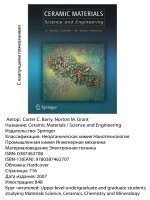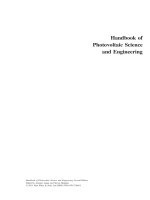catalyst preparation science and engineering
Bạn đang xem bản rút gọn của tài liệu. Xem và tải ngay bản đầy đủ của tài liệu tại đây (21.38 MB, 490 trang )
CRC Press is an imprint of the
Taylor & Francis Group, an informa business
Boca Raton London New York
CATALYST
PREPARATION
Science and Engineering
Edited by
John Regalbuto
CRC Press
Taylor & Francis Group
6000 Broken Sound Parkway NW, Suite 300
Boca Raton, FL 33487-2742
© 2007 by Taylor and Francis Group, LLC
CRC Press is an imprint of Taylor & Francis Group, an Informa business
No claim to original U.S. Government works
Printed in the United States of America on acid-free paper
10 9 8 7 6 5 4 3 2 1
International Standard Book Number-10: 0-8493-7088-4 (Hardcover)
International Standard Book Number-13: 978-0-8493-7088-5 (Hardcover)
Library of Congress Card Number 2006016073
This book contains information obtained from authentic and highly regarded sources. Reprinted
material is quoted with permission, and sources are indicated. A wide variety of references are
listed. Reasonable efforts have been made to publish reliable data and information, but the author
and the publisher cannot assume responsibility for the validity of all materials or for the conse-
quences of their use.
No part of this book may be reprinted, reproduced, transmitted, or utilized in any form by any
electronic, mechanical, or other means, now known or hereafter invented, including photocopying,
microfilming, and recording, or in any information storage or retrieval system, without written
permission from the publishers.
For permission to photocopy or use material electronically from this work, please access www.
copyright.com ( or contact the Copyright Clearance Center, Inc. (CCC)
222 Rosewood Drive, Danvers, MA 01923, 978-750-8400. CCC is a not-for-profit organization that
provides licenses and registration for a variety of users. For organizations that have been granted a
photocopy license by the CCC, a separate system of payment has been arranged.
Trademark Notice: Product or corporate names may be trademarks or registered trademarks, and
are used only for identification and explanation without intent to infringe.
Library of Congress Cataloging-in-Publication Data
Catalyst preparation: Science and Engineering / edited by John Regalbuto.
p. cm.
Includes bibliographical references and index.
ISBN-13: 978-0-8493-7088-5 (alk. paper)
ISBN-10: 0-8493-7088-4
1. Catalysts Handbooks, manuals, etc. 2. Catalysts Synthesis Handbooks,
manuals, etc. I. Regalbuto, John R. (John Robert), 1959-
QD501.H216 2007
541’.395 dc22 2006016073
Visit the Taylor & Francis Web site at
and the CRC Press Web site at
7088_Discl.indd 17088_Discl.indd 1 11/10/06 9:34:06 AM11/10/06 9:34:06 AM
Dedication
This book is dedicated to the memory of Professor James A. Schwarz. At his November
8, 1999 lecture to the Catalysis Club of Chicago (“The Nature of Protons on the
Surfaces of Catalytic Materials”) Professor Schwarz was introduced by Professor
Regalbuto with the following poem.
My Hero
Hold it right there, folks,
We have with us tonight
A pioneer of catalyst
Preparation science.
Of his impact on my research
I will gladly tell the tale.
I may have laid some concrete but
Jim Schwarz has blazed the trail.
He’s a man of the likes
There are very few others.
This professor is my hero,
Mentor and soul brother.
7088_Prelims.fm Page iii Friday, November 10, 2006 9:46 AM
7088_Prelims.fm Page iv Friday, November 10, 2006 9:46 AM
v
Preface
Catalysis is vital to the world’s economy and standard of living, yet relatively little
attention is paid to optimizing catalytic materials through rational methods of prep-
aration. More and more we hear the call to “transform the art of catalyst preparation
into a science.” A robust answer to that call is the first chapter-themed book devoted
to catalyst synthesis, Preparation of Solid Catalysts (Ertl, Knözinger, and Weitkamp,
Eds., Wiley-VCH, 1999). This excellent compendium of materials and preparation
methods contains material now almost a decade old. I hope that Catalyst Prepara-
tion: Science and Engineering can contribute to worldwide efforts in catalyst prep-
aration science.
I suggest that these efforts require a substantially different and complementary
focus from traditional catalysis. Along traditional paths there is much excellent
progress with state of the art analytical and computational methods to obtain structure-
function relationships: correlations of the atomic-scale physical and chemical makeup
of catalytic materials to their reactivity. This research tells us why a particular catalyst
works well or poorly, and in the best computational cases, precisely which catalytic
material should be prepared and with what atomic arrangement.
Getting there is another story. We might eliminate a great deal of empiricism in
catalyst development with a fundamental understanding of the genesis of structure;
from an antecedent preparation-structure relationship. How can a particular catalyst
composition and morphology be effectively synthesized? When must attention be
paid to the initial distribution of catalyst precursors on a support surface, and when
does migration during pretreatment render this inconsequential? What methods are
readily scalable and industrially feasible?
A focus on the synthesis of heterogeneous solids is inherently interdisciplinary:
material science, colloid chemistry, geophysics. However, the same characterization
tools and computational methods that are used to elucidate structure-function
correlations can be brought to bear on preparation-structure relationships. While
laborers are perhaps few, the field of catalyst preparation science is ripe! I hope
this message comes across clearly in the content to follow.
The book was inspired by several sources. At the beginning of my career I
recall muttering excitedly about the elegant simplicity of J. P. Brunelle’s landmark
paper (Pure and Applied Chemistry 1978, 50, 1211) on the electrostatic nature of
metal adsorption onto oxides, and seeing it confirmed in a comprehensive study of
Pd anion and cation adsorption onto alumina (C. Contescu and M. I. Vass, Applied
Catalalysis 33, 1987, 259). I have been greatly influenced by the research, and
moreover the friendship, of the late James A. Schwarz, who laid much groundwork
with prolonged, systematic studies of the chemical fundamentals of many catalyst
impregnation systems.
7088_C000.fm Page v Friday, November 17, 2006 10:16 AM
vi Preface
Jim’s work in preparation fundamentals culminated in his (along with coauthors
Cristian Contescu and Adriana Contescu) 1995 review, “Methods for Preparation of
Catalytic Materials” (Chem. Rev. 1995, 95, 477). The synthesis of bulk materials
was described in an initial section on three-dimensional chemistry followed by
a section on two-dimensional chemistry which reviewed the various aqueous,
organic, vapor, and solid phase methods to apply catalyst precursors to support
surfaces.
It was around this outline that a two day, four-session symposium, “The Science
and Engineering of Catalyst Preparation,” was organized for the 227th ACS meeting
in Anaheim, California. Much of the material in this book stems from that sympo-
sium, and the order has been largely retained. I had the pleasure of cochairing one
of those sessions with Jim, and have deeply felt his absence in the subsequent editing
of this book.
Thus the first section to follow pertains to the synthesis of bulk materials
including amorphous and mesoporous oxide supports (chapters 1–4), heteropoly-
acids (chapter 5), and colloidal metals (chapter 6). The second section covers the
synthesis of heterogeneous materials, and has been divided into syntheses in
nanoscale domains (chapters 7–10) and those based on two-dimensional metal
complex-substrate interactions (chapters 11–14), or a clever way around non-
interacting precursors via viscous drying (chapter 15). Effects of drying (chapter
16) and pretreatment (chapter 17) comprise the third section of the book.
A final source of inspiration has been the quadrennial conference founded by
Profs. Bernard Delmon, Pierre Jacobs, and George Poncelet in 1975: The Interna-
tional Symposium on the Scientific Bases for the Preparation of Heterogeneous
Catalysts. With its ninth meeting in 2006, this symposium continues to be the
hallmark worldwide conference on catalyst preparation fundamentals. The proceed-
ings of all these symposia are published by Elsevier, all but the first in Studies in
Surface Science and Catalysis. These tomes contain vast deposits of information
in far-ranging areas. I’m honored to have had Professor Delmon contribute a
prognostication on the future of catalyst preparation (chapter 18) to this work.
I wish to thank the Degussa Corporation of Hanau-Wolfgang, Germany, the
Petroleum Research Fund of the American Chemical Society, and the ACS’ Division
of Colloid and Surface Science for a matching grant. Financial support from these
institutions facilitated the participation of a large number of international researchers
in the The Science and Engineering of Catalyst Preparation symposium.
John R. Regalbuto
Department of Chemical Engineering
University of Illinois at Chicago
7088_C000.fm Page vi Friday, November 17, 2006 10:16 AM
vii
About The Editor
John R. Regalbuto is a professor of chemical engineering at the University of
Illinois at Chicago. He has twice served as president of the Chicago Catalysis Club
and was on the organizing committee of the 15th North American Meeting of the
Catalysis Society held in Chicago. He is active in organizing catalysis sessions
for meetings of the American Chemical Society and the American Institute of Chem-
ical Engineers. He has lectured around the world on catalyst preparation and
characterization.
7088_C000.fm Page vii Friday, November 17, 2006 10:16 AM
7088_C000.fm Page viii Friday, November 17, 2006 10:16 AM
ix
Contributors
Michael D. Amiridis
University of South Carolina
Columbia, South Carolina
Lekhal Azzeddine
Rutgers University
Piscataway, New Jersey
Justin Bender
University of Illinois at Chicago
Chicago, Illinois
Ken Brezinsky
University of Illinois at Chicago
Chicago, Illinois
Laura E. Briand
Universidad Nacional de La Plata
Buenos Aires, Argentina
Hung-Ting Chen
Iowa State University
Ames, Iowa
Bernard Delmon
Université Catholique de Louvain
Louvain-la-Neuve, Belgium
D. Samuel Deutsch
University of South Carolina
Columbia, South Carolina
Lawrence D’Souza
International University
Bremen, Germany
Jennifer Dunn
University of Illinois at Chicago
Chicago, Illinois
Luis A. Gambaro
Universidad Nacional de La Plata
Buenos Aires, Argentina
Bruce C. Gates
University of California
Davis, California
John W. Geus
Utrecht University
Utrecht, Netherlands
Benjamin J. Glasser
Rutgers University
Piscataway, New Jersey
Benoît Heinrichs
Université de Liège
Liège, Belgium
Seong Huh
Iowa State University
Ames, Iowa
Nathalie Job
Université de Liège
Liège, Belgium
Dieter Kerner
Degussa AG, Aerosil & Silanes
Hanau-Wolfgang, Germany
Johannes G. Khinast
Rutgers University
Piscataway, New Jersey
William V. Knowles
Rice University
Houston, Texas
7088_C000.fm Page ix Friday, November 17, 2006 10:16 AM
x Contributors
Alexander I. Kozlov
Northwestern University
Evanston, Illinois
Harold H. Kung
Northwestern University
Evanston, Illinois
Mayfair C. Kung
Northwestern University
Evanston, Illinois
Stephanie Lambert
Université de Liège
Liège, Belgium
Victor X Y. Lin
Iowa State University
Ames, Iowa
Catherine Louis
Université Pierre et Marie Curie
Paris, France
Silvana R. Matkovic
Universidad Nacional de La Plata
Buenos Aires, Argentina
Michael O. Nutt
Rice University
Houston, Texas
Gerard M. Pajonk
Université Claude Bernard-Lyon 1
Villeurbanne, France
Jean-Paul Pirard
Université de Liège
Liège, Belgium
Geoffrey L. Price
University of Tulsa
Tulsa, Oklahoma
Ryan Richards
International University
Bremen, Germany
Graciela M. Valle
Universidad Nacional de La Plata
Buenos Aires, Argentina
Christopher T. Williams
University of South Carolina
Columbia, South Carolina
Eduardo E. Wolf
University of Notre Dame
South Bend, Indiana
Michael S. Wong
Rice University
Houston, Texas
Wen-Mei Xue
Northwestern University
Evanston, Illinois
Shandong Yuan
Northwestern University
Evanston, Illinois
7088_C000.fm Page x Friday, November 17, 2006 10:16 AM
Table of Contents
Part I
Synthesis of Bulk Materials 1
Chapter 1
Flame Hydrolysis for Oxide Supports 3
Dieter Kerner
Chapter 2
Amine-Assisted Synthesis of Aluminum Oxide 15
Alexander I. Kozlov, Mayfair C. Kung, Wen-Mei Xue,
Harold H. Kung, and Shandong Yuan
Chapter 3
Aerogel Synthesis 31
Gerard M. Pajonk
Chapter 4
Fine-Tuning the Functionalization of Mesoporous Silica 45
Hung-Ting Chen, Seong Huh, and Victor S Y. Lin
Chapter 5
The Environmentally Friendly Synthesis of Heteropolyacids 75
Graciela M. Valle, Silvana R. Matkovic,
Luis A. Gambaro, and Laura E. Briand
Chapter 6
Synthesis of Metal Colloids 93
Lawrence D’Souza and Ryan Richards
Part II
Synthesis of Heterogeneous Catalysts 139
Chapter 7
Microwave-Assisted Synthesis of Nanolayer Carbides and Nitrides 141
Justin Bender, Jennifer Dunn, and Ken Brezinsky
7088_bookTOC.fm Page xi Thursday, November 9, 2006 12:33 PM
Chapter 8
Sol-Gel Synthesis of Supported Metals 163
Benoît Heinrichs, Stéphanie Lambert, Nathalie Job, and Jean-Paul Pirard
Chapter 9
Synthesis of Supported Metal Catalysts by Dendrimer-Metal Precursors 209
D. Samuel Deutsch, Christopher T. Williams, and Michael D. Amiridis
Chapter 10
Synthesis of Oxide- and Zeolite-Supported Catalysts from
Organometallic Precursors 237
Bruce C. Gates
Chapter 11
Supported Metal Oxides and the Surface Density Metric 251
William V. Knowles, Michael O. Nutt, and Michael S. Wong
Chapter 12
Solid-State Ion-Exchange of Zeolites 283
Geoffrey L. Price
Chapter 13
Strong Electrostatic Adsorption of Metals onto Catalyst Supports 297
John R. Regalbuto
Chapter 14
Deposition-Precipitation Synthesis of Supported Metal Catalysts 319
Catherine Louis
Chapter 15
Production of Supported Catalysts by Impregnation and (Viscous) Drying 341
John W. Geus
Part III
Catalyst Finishing 373
Chapter 16
Drying of Supported Catalysts 375
Azzeddine Lekhal, Benjamin J. Glasser, and Johannes G. Khinast
7088_bookTOC.fm Page xii Thursday, November 9, 2006 12:33 PM
Chapter 17
The Effects of Finishing and Operating Conditions on Pt
Supported Catalysts during CO Oxidation 405
Eduardo E. Wolf
Chapter 18
Catalysts for New Uses: Needed Preparation Advances 449
Bernard Delmon
Index 465
7088_bookTOC.fm Page xiii Thursday, November 9, 2006 12:33 PM
7088_bookTOC.fm Page xiv Thursday, November 9, 2006 12:33 PM
1
Part I
Synthesis of Bulk Materials
7088_S001.fm Page 1 Wednesday, September 20, 2006 8:47 AM
7088_S001.fm Page 2 Wednesday, September 20, 2006 8:47 AM
3
1
Flame Hydrolysis for
Oxide Supports
Dieter Kerner
CONTENTS
1.1 Manufacture 3
1.2 Physicochemical Properties of Pyrogenic Oxides 5
1.3 Preparation of Formed Supports 8
1.4 Applications 10
References 11
1.1 MANUFACTURE
The first product produced by flame hydrolysis was pyrogenic (or fumed) silica. It
was developed during World War II by the German chemist Harry Kloepfer, driven
by the need to find an alternative to carbon black based on local resources. As sand
is available everywhere and Kloepfer had knowledge about the gas black process,
he developed the idea of the flame hydrolysis of silicontetrachloride (SiCl
4
,
made
by carbochlorination of sand) to pyrogenic silica. Today, this process is known as
the AEROSIL
®
process [1], invented in 1942 by Kloepfer [2]. The details of this
process were published in 1959 and later [3, 4]. A simplified flow sheet of the flame
hydrolysis process is shown in Figure 1.1.
Silicontetrachloride is vaporized, mixed with dry air and hydrogen, and then
fed into the burner. During the combustion, hydrogen and oxygen form water,
which quantitatively hydrolyzes the SiCl
4
, forming nanoscaled primary particles
of SiO
2
. The particle size or specific surface area can be adjusted by the flame
parameters. The reaction products silica and hydrochloric acid are cooled down
by heat exchangers before entering the solid/gas separation system. Filters or
cyclones separate the silica from the off-gas (hydrochloric acid, combustion gases).
The residual hydrochloric acid adsorbed on the large surface of the silica particles
is removed in a fluidized bed or rotary kiln reactor. The chemical reaction can be
described as a high-temperature hydrolysis of SiCl
4
:
2H
2
+ O
2
→ 2H
2
O (1.1)
SiCl
4
+ 2H
2
O → SiO
2
+ 4HCl (1.2)
7088_C001.fm Page 3 Wednesday, November 15, 2006 11:08 AM
4 Catalyst Preparation: Science and Engineering
SiCl
4
+ 2H
2
+ O
2
→ SiO
2
+ 4HCl (1.3)
Silicontetrachloride vapors are hydrolyzed in a hydrogen-oxygen flame by water
vapors (Equation 1.2), which have been formed by the combustion of hydrogen in
oxygen or air (Equation 1.1). The overall reaction is given in Equation 1.3.
The general mechanism of formation and growth of the silica particle occurring in
the flame reactor can be described as follows [5–7]: At first, spherical primary particles
are formed by the flame hydrolysis through nucleation. Further growth of these primary
particles is accomplished by the reaction of additional SiCl
4
on the surface of the already
generated particles. By means of coagulation (collision of primary particles) and
coalescence (sintering), primary particles form aggregated structures [8–12]. Accumu-
lations of primary particles can be described by the expressions aggregate and agglom-
erate. An aggregate is a cluster of particles held together by strong chemical bonds.
Agglomerates, however, are defined as loose accumulations of particles (aggregates)
sticking together by, for example, hydrogen bonds and van der Waals forces. For
definitions and illustrations, see Reference 13. Figure 1.2 shows the growth of particles
to aggregates and agglomerates in relation to the residence time in the flame reactor.
The formation of primary particles is already completed within a short time, whereas
the extent of aggregation and agglomeration increases with the residence time in the
reactor [14]. Theoretical investigations are supporting the experimental results [15, 16].
The size of the primary particles and the degree of aggregation and agglomeration
can be influenced by the flame temperature, the hydrogen-to-oxygen ratio, the sili-
contetrachloride concentration, and the residence time in the nucleation and aggre-
gation zone of the flame reactor. Besides silicontetrachloride, methyltrichlorosilane
(MTCS) or trichlorosilane (TCS) are used as raw materials in the AEROSIL process.
Also, non-chloride-containing raw materials like D4 (octamethyltetrasiloxane) and
FIGURE 1.1 Schematic drawing of the flame hydrolysis process.
7088_C001.fm Page 4 Wednesday, November 15, 2006 11:08 AM
Flame Hydrolysis for Oxide Supports 5
tetramethoxysilane (TMOS) have been reported [17, 18]. The worldwide production
capacity for pyrogenic silica was estimated to be above 120,000 tons per annum in
2002 [19]. It is by far the most widely produced pyrogenic oxide [20]. The main
producers are Degussa (AEROSIL
®
), Cabot (CAB-O-SIL
®
), Wacker (HDK
®
), and
Tokuyama (REOLOSIL
®
). The process is not limited to SiO
2
. Aluminum oxide and
titanium dioxide have been made based on the respective metal chlorides and are
today available on a commercial scale, as well as silica-alumina mixed oxides [8].
Various other pyrogenic oxides have been reported by Kleinschmit et al. [21, 22].
1.2 PHYSICOCHEMICAL PROPERTIES OF
PYROGENIC OXIDES
One key parameter is the surface area, which is mainly determined by the size of
the primary particles formed during the nucleation process in the flame reactor. For
commercial pyrogenic silica products, surface areas lie between 50 and 400 m
2
/g
–1
,
which corresponds to primary particles of approximately 40 to 7 nm. The silica
consists of amorphous, spherical particles without an inner surface area, which are
aggregated and agglomerated, as described in Section 1.1.
Materials with a specific
surface area above 300 m
2
/g
–1
have a certain amount of micro-porosity instead of a
further reduced primary particle size. In pyrogenic silica, the SiO
4
tetrahedrons are
arranged randomly. Therefore, a distinct and well-defined x-ray pattern—as obtained
with any crystalline silica modification occurring in nature (like quartz or christo-
balite)—cannot be observed [8]. The x-ray photograph of pyrogenic silica is char-
acterized by the absence of a diffraction pattern, indicating an entirely amorphous
material. In contrast to the crystalline forms, this material does not cause silicosis.
Although made in an oxygen-hydrogen flame, pyrogenic alumina (AEROXIDE
®
Alu C, Degussa) has a crystalline structure consisting of the thermodynamically
metastable γ- and δ-forms instead of the stable α-form [23]. The primary particle size
FIGURE 1.2 Average primary particle and aggregate size.
7088_C001.fm Page 5 Wednesday, November 15, 2006 11:08 AM
6 Catalyst Preparation: Science and Engineering
is in the range of 13 nm; the specific surface area is ~100 m
2
/g
–1
. At temperatures above
1200°C, pyrogenic alumina can be transformed to α-Al
2
O
3
, which is associated with a
decrease in the specific surface area and enlargement of the primary particles. Pyrogenic
titania (AEROXIDE TiO
2
P 25, Degussa) has an average primary particle size of about
20 nm and a specific surface area of about 50 m
2
/g
–1
[23]. This product differs signif-
icantly from pigmentary TiO
2
produced through precipitation processes, with average
particle diameters of several hundred nm and surface areas in the range of 10 m
2
/g
–1
.
In the pyrogenic TiO
2
, the thermodynamically metastable anatase phase (~80%)
is the dominant modification over rutile (~20%). At temperatures above 700°C, a
lattice transformation towards higher amounts of rutile is observed and associated
with a decrease of specific surface area. Pyrogenic zirconium dioxide (VP ZrO
2
from Degussa) is predominantly monoclinic and, to a lesser degree, tetragonal. Here
also, despite the flame genesis, the low-temperature form is found to a greater degree
than the high-temperature form. This ZrO
2
has an average primary particle size of
30 nm and a specific surface area of about 40 m
2
/g
–1
[23]. At temperatures around
1100°C, the conversion from a monoclinic to a tetragonal structure is observed,
followed by another transformation at about 2300°C from tetragonal to cubic. The
transformation from monoclinic to tetragonal is associated with an increase of
density (monoclinic: 5.68 g/cm
–1
; tetragonal: 6.10 g/cm
–1
) and has a negative effect
on the thermal resistance of, for example, molded ceramic parts, up to the point
where the formation of microcracks is observed [24]. By addition of dopants, high-
temperature modifications can be stabilized far below their original transformation
point [24–26]. Y
2
O
3
is the most common stabilization aid. TEM photographs of four
different pyrogenic oxide grades are shown in Figure 1.3.
FIGURE 1.3 TEM photograph of different pyrogenic oxides.
7088_C001.fm Page 6 Wednesday, November 15, 2006 11:08 AM
Flame Hydrolysis for Oxide Supports 7
Table 1.1 provides an overview of the physicochemical properties of pyrogenic
oxides.
Besides their comparatively large specific surface area, their well-defined spher-
ical primary particles, and their high chemical purity, the surface chemistry of
pyrogenic oxides is another reason for their use in catalytic applications. Siloxane
(Si-O-Si) and silanol groups (Si-OH) are the main functional groups (Figure 1.4)
on the surface of pyrogenic silica.
The hydrophilic character of the silanol groups dominates the surface chem-
istry and makes pyrogenic silica wettable. The density of the silanol groups can
be determined, for example, by the reaction with lithium aluminum hydride and
varies between 1.8 and 2.7 Si-OH nm
–2
[8]. By exposure to humid conditions
(water), siloxane groups react to form additional silanol groups on the surface
of pyrogenic silica. This reaction can be reversed (dehydroxylation) by heating
pyrogenic silica up to temperatures above 150°C. Through infrared spectroscopy,
changes in the moisture balance at different temperatures of pyrogenic silica
can easily be detected and followed [27–29]. The hydroxyl groups are acidic,
resulting in an isoelectric point at a pH value of 2. Pyrogenic Al
2
O
3
has basic
hydroxyl groups at its surface that react weakly alkaline in water, corresponding
TABLE 1.1
Physicochemical Properties of Pyrogenic Oxides
AEROSIL
OX50
AEROSIL
200
AEROXIDE
AluC
AEROXIDE
TiO
2
P 25 VP ZrO
2
Specific surface area
by BET (1)
m
2
g
–
1
50±15 200±25 100±15 50±15 40±10
Average size of
primary particles
nm 40 12 13 21 30
Tapped density (2) g/l ~130 ~50 ~50 ~130 ~80
Density (3) g/ml ~2.2 ~2.2 ~3.2 ~3.7 ~5.4
Purity (4) Wt. % SiO
2
≥99.8 SiO
2
≥99.8 Al
2
O
3
≥99.6 TiO
2
≥99.5 ZrO
2
≥96
Loss on drying (5) Wt. % 1.5 1.5 5 1.5 2
Loss on ignition (6, 7) Wt. % 11 3 2 3
Isoelectrical point
at pH
2 2 9 6.5 8.2
Phase composition Amorphous Amorphous γ and δ
modification
80% anatase,
20% rutile
Monoclinic
and tetragonal
1. According to DIN 66131.
2. According to DIN ISO 787/XI, JIS K 5101/18 (not screened).
3. Determined with a pynknometer.
4. Based on material ignited for 2 hours at 1000°C.
5. According to DIN ISO 787/II, ASTM D 280, JIS K 5101/21.
6. According to DIN 55921, ASTM D 1208, JIS K 5101/23.
7. Based on material dried for 2 hours at 105°C.
7088_C001.fm Page 7 Wednesday, November 15, 2006 11:08 AM
8 Catalyst Preparation: Science and Engineering
to an isoelectric point at a pH value of 9. The total dehydroxylation of alumina
results in the presence of aluminum ions located at the surface, coordinated by
only five rather than six oxygen atoms, thus representing Lewis acid centers.
These centers can either add pyridine or be rehydroxylated through the adsorp-
tion of water [30]. Depending on the coordination of the hydroxyl groups at the
surface of titania, an acidic as well as a basic character of these groups can be
observed. Although the acidic sites react with ammonia and diazomethane, the
basic sites can be detected by exchange reactions with anions. The acidic and
basic hydroxyl groups are also reflected in an isoelectric point at a pH value of
6.5 [31]. Zirconia shows a similar surface chemistry. However, relative to titania,
zirconia has more basic rather than acidic sites, resulting in an isoelectrical point
at a pH value of 8.2. Figure 1.5 illustrates the zeta potential of the pyrogenic
oxides mentioned in this chapter.
1.3 PREPARATION OF FORMED SUPPORTS
The fine and fluffy pyrogenic oxides are not very convenient for use in catalysis
unless the powder shall not be part of the final product. Shaping processes can help
FIGURE 1.4 Surface groups of pyrogenic silica.
FIGURE 1.5 Zeta potentials of different pyrogenic oxides.
Silanol Groups
Siloxane Group
(hydrophilic)
(hydrophobic)
free geminal vicinal
and bridged
H
H
H
H
H
O
O
O
OO
O
S S SS SS
80
60
40
20
0
–20
–40
–60
–80
98765432 10
pH value
Zeta potential mV
VP Zirconium Oxide
Aluminium Oxide C
Titanium Dioxide P 25
AEROSIL
®
OX 50
7088_C001.fm Page 8 Wednesday, November 15, 2006 11:08 AM
Flame Hydrolysis for Oxide Supports 9
make more convenient supports, especially for the use in fixed-bed reactors. The
requirements for an excellent support are summarized in Reference 32:
• Well-defined chemical composition
• High purity
• Well-defined surface chemistry
• No sintering at high temperatures
• Good abrasion resistance and crushing strength
• Well-defined porosity, pore size distribution, and pore volume
• Easy separation from the reactants
Pyrogenic oxides in powder form only fulfill part of the requirements. Catalysts
made by impregnation of oxide powders were of only academic interest for a long
time because, in technical scale, problems arose when separating the powder from
the products. These disadvantages can be overcome by size enlargement, meaning
compaction of the powder. Options for size enlargement to make formed supports
are [33] agglomeration, spray drying or spray granulation, pressure compaction, or
extrusion. Agglomeration processes are not convenient for pyrogenic oxides because
of their fluffiness. In the spray drying process, a suspension of pyrogenic oxides in
water is fed via a spraying device into the chamber of a spray dryer. Microgranulates
of pyrogenic silica [34, 35], alumina [36], and titania [37] have been reported using
the spray drying method. The properties of the resulting spheres can be controlled
by the solid content of the pyrogenic oxide in the suspension, the type of spraying
devices, and the residence time and temperature in the spraying chamber. Typically,
spheres in the range of 10–150 µm can be achieved. The pore size and pore size
distribution can be adjusted by selecting oxides with different particle size distribu-
tions and surface areas, respectively.
In lab scale, pressure compacting (making
tablets) is used for basic investiga-
tions on the processability and performance of newly developed recipes, whereas
in pilot and production scale, extrusion is the preferred method. Basically, both
processes follow the same schematic procedure. The desired properties can be
achieved using auxiliaries like plasticizers or pore building substances. A simple
way of making tablets from pyrogenic silica, alumina, and titania using silica sol
as a binder and polyfunctional alcohols as plasticizer is described in Reference
38. The corresponding pyrogenic oxide is mixed with water, silica sol, and glyc-
erol; pelletized; dried at ambient temperature; and calcined at 550°C. The tablets
consist of 50–60% void volume, and the initial surface area of the powder is
reduced by less than 20%. Deller et al. describe the use of various auxiliaries like
kaolin, graphite, sugar, starch, urea, and wax as binders and pore building agents
for making pellets of pyrogenic silica [39, 40], alumina [41], zirconia [42], and
silica-alumina mixed oxides [43]. A detailed description of the extrusion process
of pyrogenic titania is given in References 44 and 45. It consists of four crucial
process steps: kneading the raw materials, extrusion, drying of the green bodies,
and calcination. Figure 1.6 shows a picture of an extruder and the corresponding
extrudates made.
7088_C001.fm Page 9 Wednesday, November 15, 2006 11:08 AM
10 Catalyst Preparation: Science and Engineering
1.4 APPLICATIONS
Because of their unique properties like purity and well-defined and accessible sur-
face, pyrogenic oxides are used as model substances. A review up to the year 1980
is given in Reference 46 about the investigation of silica (26 references), alumina
(11 references), and titania (4 references). As can be seen, the major focus of mainly
basic investigations was on pyrogenic silica rather than the other oxides. In com-
mercial applications, silica supports play an important role in the synthesis
of vinylacetate monomers: Wunder in Reference 47 describes the use of Pd- or Au-
impregnated cylindrical supports made of either pyrogenic silica or a mixture of
silica and alumina. Formed silica or alumina is also used as a support in catalysts
where the support is impregnated with Pd/K/Cd, Pd/K/Ba, or Pd/K/Au, giving a
selectivity of above 90% [48, 49]. Bankmann et al. [50] describe improved vinylac-
etate catalysts based on formed silica and silica/alumina with various shapes. Silica
supports in the form of pellets, beads, or globular shape impregnated with phosphoric
acid are used in the hydration of olefins in a fixed bed reactor [51].
In a rather basic study of the gas phase polymerization of ethane, it could be
shown that the activity of catalysts using pyrogenic silica as support for metallocenes
is 10 times higher than with other silica supports [52]. Pyrogenic alumina is used
in automotive catalysts. Modern three-way catalysts consist of an alumina washcoat
containing one or more of the elements Pt, Rh, Pd, and so-called storage components
for NOx and oxygen, respectively. Liu and Anderson investigated the stability of
stored NOx [53, 54]. NOx is stored under lean-burn conditions on an alumina-
supported alkaline earth oxide component (10% BaO on Al
2
O
3
), released during
intermittent rich/stoichiometric periods, and reduced by hydrogen, CO, or hydro-
carbons over the noble metal component. Similarly, oxygen can be stored under
FIGURE 1.6 Extruder and extrudates.
7088_C001.fm Page 10 Wednesday, November 15, 2006 11:08 AM









